|
RMT Duros 1214
Rugged fixed-mount 12-inch display computer for industrial use
(by Conrad H. Blickenstorfer -- view review as PDF)
Early 2009, RMT, Inc., -- a provider of rugged and highly customizable hardware ranging from handhelds to tablets to fixed and vehicle mounts -- introduced the Duros 1214 terminal. Those familiar with RMT's lineup will notice that the company's fixed-mount models that used to carry the "JLT" designation to indicate their origin are now all offered under the "Duros" family name. The Duros 1214 is the latest addition to that highly regarded line of tough and rugged terminals that are sealed to very high IP-65 specifications and pass all the requisite MIL-STD 810F ruggedness tests.
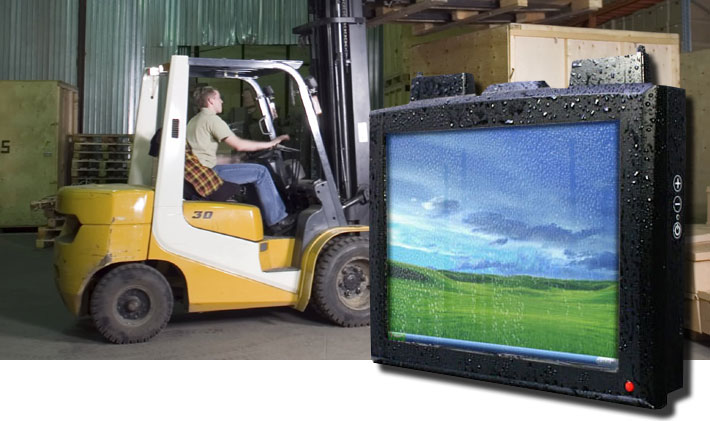
Equipped with a bright 12.1-inch SVGA resistive touch screen and powered by an efficient 1GHz Intel Celeron M processor, the rugged Duros computer comes with up to 64GB of CompactFlash. As a fixed-mount computer, the Duros 1214 generally runs on external power, but also has an internal UPS for backup. The machine can be equipped with integrated Bluetooth and WiFi, and there are highly effective dual-diversity antennas. Built to run a variety of different operating systems, this rugged fixed-mount PC is primarily geared towards use in warehousing and shipping environments, but certainly has application in a variety of other areas.
What are the RMT Duros 1214's differentiating features? Like other members of the Duros line, the system feels more solid than most, even compared to other rugged and panel-mount machines. It is also designed for maximum ease-of-use. Apart from a plus and a minus button on the side for brightness adjustment, there aren't any additional controls to figure out and manipulate -- it's all done via touch. There isn't an abundance of doors and hinges either; all connectors are in one block in the back. Powered by an efficient and cool-running Intel Celeron M processor, the Duros doesn't need a fan. It therefore operates silently and there's no need to worry about dust or water entering the enclosure through cooling slots. The Duros 1214's designers obviously put lot of thought into creating a machine that never gets in the way and simply does its job quietly and reliably.
Display
The RMT Duros 1214 touch screen display measures 12.1 inches diagonally and has 800 x 600 pixel SVGA resolution. It has a wider than average viewing angle and an anti-reflective surface treatment that makes the screen very bright and crisp and pleasant to use. Since customers may use the Duros 1214 in brightly lit or outdoor environments, the Duros screen has a strong 450 nits backlight, far brighter than that of most consumer laptops that have backlights of less than 200 nits. The special reflective treatment makes it possible to use the computer outdoors without washing out or having excessive reflections. Screen brightness can be adjusted from off to 100% in 15 steps via the + and - buttons on the side.
One potential issue is that the side bezel around the perimeter of the display is fairly thick and tall, so it can be a bit difficult to manipulate objects close to the edges of the screen with your finger.
Targeted performance
Since they are generally used for specific and well-defined custom applications, fixed or vehicle-mount computer like the RMT Duros 1214 rarely require the raw computing power of a general-purpose desktop or laptop computer. The device must be quick and responsive enough to satisfy users, but not so powerful that heat dissipation and battery drain become an issue. Processor experts call this "targeted" performance, i.e. exactly enough performance for a given or anticipated application. A machine like the Duros 1214 is usually run with external or vehicle power, so battery life is not an issue. Heat generation, however, is always an issue, and so is power consumption, both of which should be minimized. Desired processing power also depends on the choice of operating system. RMT decided to be very flexible here and make it so the Duros 1214 can run a range of operating systems, beginning with very lean ones such as Windows XP Embedded or Linux, but also standard XP and even resource-intensive platforms like Windows Vista.
To meet all of the above requirements and possibilities, RMT chose the Intel Celeron M ULV 373. The 373 is part of Intel's "Dothan" family, a 90nm ultra-low-voltage design that runs at a maximum speed of 1.0GHz, has 512MB of L2 cache, and has a Thermal Design Power (DTP) of just five watts. While this chip has been around for a few years, it packs 144 million transistors (as opposed to under 50 million on newer Atom chips) and is capable of serious work. Even with other processor options available now, the Celeron 373 remains an attractive choice.
Our review machine came with Windows XP Professional SP3, running on just 512MB of RAM. Instead of a hard disk, the computer used 8GB of Flash. Performance was FAR quicker than I expected from a device with such a modest processor. The machine flies. In fact, I initially thought this was because the machine was running Windows XP Embedded.
Design and construction
Pick up and examine this machine and it's immediately obvious that "Duros" is a good name for it. It certainly feels durable enough to handle just about any job. From a structural design point of view, the 1214 is an exceedingly solid machine that consists of a top and a bottom part, both aluminum alloy with a black powdercoat finish. Below you can see a head-on as well as the bottom and side views.
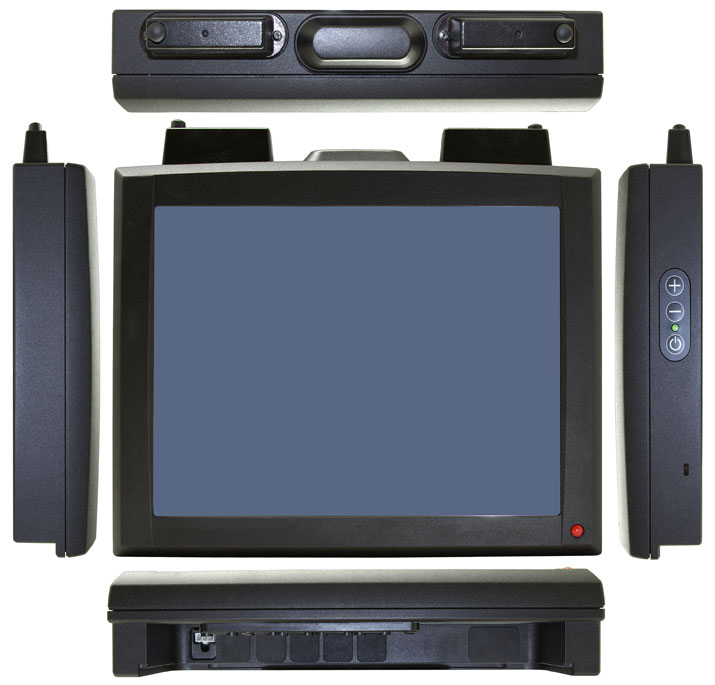
Overall dimensions are 11.9 by 9.8 inches (plus a bit for the various radio antenna protrusions), and the computer is about 2.2 inches thick. All interface ports are in the back, facing down.
At RuggedPCReview.com we take a peek inside test units whenever possible, to see if inside design and quality match the outside. The housing of the Duros 1214 consists of two halves that are securely held together via seven large screws. A continuous rubber O-ring around the entire perimeter forms a dust and water-tight seal. The top part contains the LCD and touchscreen, all hidden beneath a separate metal plate that protects and shields the display assembly and makes for a very neat interior. The motherboard itself is very clean, robust and well laid out, without excessive wires or small parts hanging from it. The whole construction is ultra-solid. There is nothing that can break or bend in here.
Below you can see the inside of the RMT Duros 1214:
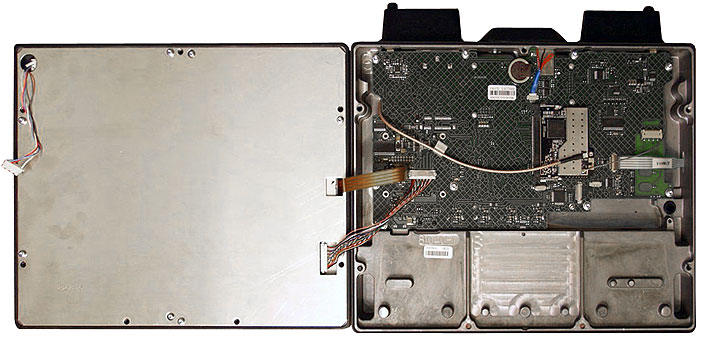
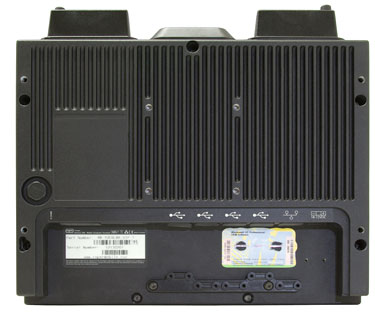 The module in the center is the 802.11b/g WiFi radio, a Uqiquitu Networks (ubnt.com) SuperRange2 2.4GHz hi-performance Mini-PCI module using the Atheros chipset (http://ubnt.com/products/sr2.php). Note that the entire layout is very friendly for service and customization. The module in the center is the 802.11b/g WiFi radio, a Uqiquitu Networks (ubnt.com) SuperRange2 2.4GHz hi-performance Mini-PCI module using the Atheros chipset (http://ubnt.com/products/sr2.php). Note that the entire layout is very friendly for service and customization.
The top of the unit has three protrusions for the two dual-diversity radio antennas, "dual-diversity" meaning the use of separate antennas for the same frequency, so that one with the better signal can provide uninterrupted optimal reception. This type of arrangement uses physically separated antennas with polarization diversity so that fade will only affect one, with the best signal then being used.
While the unit is well sealed, keep in mind that proper protection depends on the individual rubber plugs being in place as there is no additional sealing on them.
Mounting is via standard VESA mount, with the 3 x 3 inch square screw pattern, and a second set at 11.4 x 5.3 (see picture of the backside of the unit to the right). A variety of mounting solutions are available, including an H-plate mount, a locking or standard RAM Ball Mount available in a variety of diameters and lengths, as well as NEMA4-sealed iKey keyboards, a variety of bare leads and quick-connect cables for installation, and more.
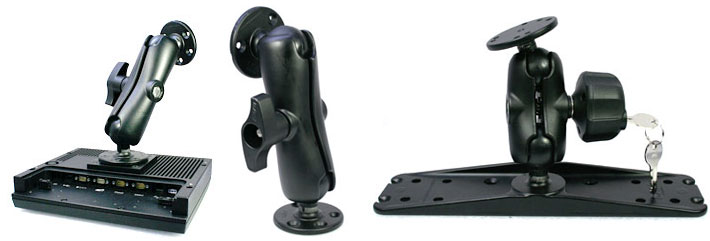
The Duros 1214 is designed to use external power, but also has an internal Kontron Ni-Cad SmartBattery backup that's good for at least several minutes. This means the system is immune to external power glitches. In our testing, the integrated UPS provided backup power for about half an hour. If you look at the power specs, you see that the 1214 can handle a very wide input power range from 9 to 72 Volts DC. That's to match the large power range available in today's forklifts. When used with older lifts or vehicles with 12 volts, a simple power step-up can be installed.
The UPDD Console
The RMT Duros comes with the handy UPDD Console utility to manage a number of the unit's functions and to provide systems information. The available screens are as follows:
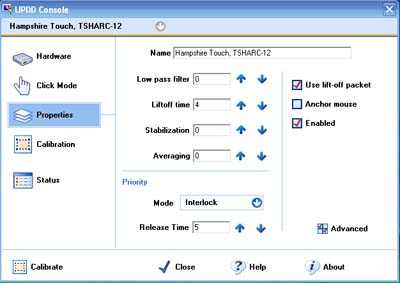
- Hardware: Tells you what USB port the touch screen uses, and how the desktop should be handled
- Click Mode: Lets you select the click mode (click and drag, drag then click, point and click, interactive touch), the switch delay, system mouse settings, as well as testing right clicks and double clicks.
- Properties: Some fairly advanced items for those who know how to fine-tune a touch screen: low pass filter, liftoff time, stabilization, averaging, priority and so on. There is also an advanced properties panel that lets you set edge acceleration of the touch screen and also lets you set the display so that touches outside of a calibrated area are ignored.
- Calibration: Lets you set the number of points (up to 25) that you use with calibration, the margin in %, as well as the timeout in seconds. The ability to calibrate 25 points instead of just four or nine increases accuracy and is much appreciated.
- Status: This screen shows a variety of fairly advanced diagnostics.
Every screen of the UPDD Console utility has a detailed help screen that explains all of the possible settings and configurations.
Operating Systems
RMT can ship the Duros 1214 with a variety of different operating systems. Those include Linux, Windows XP, Windows XP Embedded, and even Windows Vista. Which is best? That depends entirely on the intended application.
Our tester came with XP Professional, but many units will undoubtedly be ordered with XP Embedded and this requires a bit of explanation which those who are familiar with embedded operating systems can skip:
A general purpose OS, like Windows XP Pro, is just that, general purpose. You can do anything you want with it, and run anything you want on it. With that in mind, Microsoft equipped Windows XP with all the drivers and software and utilities one could possibly need. The result is a rather large OS with numerous processes and services running all the time, all consuming memory and power.
An embedded operating system is totally different. The idea is to only use what you need to perform a certain task and leave everything else behind. This greatly reduces the size of the operating system and dramatically reduces hardware requirements. XP Embedded is generally used for smart, connected and service oriented commercial and consumer devices that do not need all of Windows XP, yet can still run thousands of existing Windows applications. An embedded OS can easily be as small as 40MB and it's even possible to cut it all down to around 8MB with a bootable kernel.
XP Embedded is not one-size-fits all. A company will determine exactly what a machine is for and what it should be able to do. They then include as many components (hence the term "componentized" operating system) as they need. There are over 10,000 available and it's easy to create lean, nimble embedded OS platforms that can still do sophisticated high level tasks like advanced multimedia, browsing, communications or whatever a task requires. An embedded OS can even run as a real-time OS via third party plug-ins. Essentially you get the power of the basic Windows XP engine, but without any overhead you don't need.
Note that configuring and building a Windows XP Embedded image requires considerable expertise. RMT has been dealing with XP Embedded for a long time and can develop and manage customer images. They also work with Wavelink, a company specializing in mobile device and wireless infrastructure management, to handle and distribute images or do remote updates.
Why isn't the XP Tablet PC Edition available? That's because the Tablet PC Edition shines on machines that have an active digitizer, which the touch screen-equipped Duros does not. Given Vista's significant resource requirements we'd probably stay away from using it on a machine like the Duros, though if RMT says the machine can run Vista, it obviously can. Note that Vista includes the former Tablet PC Edition's functionality.
Ruggedness
The RMT Duros 1214 is a fully rugged machine designed to easily hold up to rough handling and demanding environmental conditions. The heavy-duty aluminum housing seems just about invulnerable.
The environmental spec sheet of the RMT Duros is quite impressive. The machine has an extremely wide operating temperature range of -22 to 131 degrees Fahrenheit, which means it can be operated in freezers and on other assignments where it will encounter freezing temperatures. Since the Duros uses CompactFlash and not a standard hard disk, it can easily meet and exceed MIL-STD-810F specified procedures. Water and dust protection is at the IP65 equivalent, where the 6 stands for total protection against dust, and the 5 for protection against low pressure jets of water from all directions.
The machine can handle 10 - 95% humidity; three hours worth of 5 - 500 Hz/4.5 g RMS and survive 30 g of shock for 11 milliseconds.
RMT also lists a variety of regulatory approvals that may or may not be relevant to specific customers. Approvals include Din 40050 Part 9 IEC 529; Safety: UL94, Class VO; FCC: Part 15, Subpart B and C; International Safety: CE; Electrical: ISO7637-2, EN61000-6-2, EN55022 + A1 + A2.
The RMT Duros 1214 fixed-mount computer: bottom line
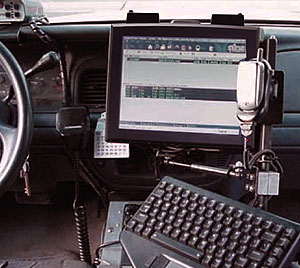 The Duros 1214 is the latest addition to a line of rugged and highly configurable vehicle-mount and fixed-mount computers made by one of the most respected manufacturers in the business. The platform was designed from the ground up for ease-of-use and the ability to hold up in a variety of demanding warehousing, shipping and other industrial applications. Despite having a large display, the Duros 1214 is unusually compact and light for a machine of this type, with a footprint of just 12.0 x 9.5 inches and weighing under eight pounds. The attractive and very solid matte-black housing with a durable powdercoat finish is made of aluminum and should be able to withstand rough handling.
The Duros 1214 is the latest addition to a line of rugged and highly configurable vehicle-mount and fixed-mount computers made by one of the most respected manufacturers in the business. The platform was designed from the ground up for ease-of-use and the ability to hold up in a variety of demanding warehousing, shipping and other industrial applications. Despite having a large display, the Duros 1214 is unusually compact and light for a machine of this type, with a footprint of just 12.0 x 9.5 inches and weighing under eight pounds. The attractive and very solid matte-black housing with a durable powdercoat finish is made of aluminum and should be able to withstand rough handling.
Designed to primarily run custom applications quietly and reliably, the Duros uses a modest 1GHz Intel Celeron M processor that consumes little power and does not need a cooling fan. Likewise, the Duros 1214 uses CompactFlash and there is no hard disk. Performance depends on your choice of operating system. A Windows XP-based test unit felt quick and responsive.
The 12.1" display is bright and has a responsive and very configurable touch screen. The strong backlight (450 nit) easily allows the unit to be used outdoors. The display can be adjusted from off all the way to full power.
The Duros 1214 is a rugged unit that is totally sealed against dust and can also handle water jets from all sides. It has an exceptionally wide operating temperature range (-22 to 131 degrees Fahrenheit) and you generally never have to worry about it getting damaged.
The machine offers good connectivity via four USB 2.0 ports, a LAN port, and an expansion port, all located in the back of the unit, facing down, and individually sealed. There are integrated Bluetooth and WiFi options, and dual-diversity antennas for optimal reception. The Duros uses external power, but also has an internal UPS backup to guard against power fluctuations, or final work after external supplies have been powered down. Overall, this machine is designed for simple, reliable operation in vehicle and other fixed-mount applications.
Update April 26, 2010: RMT announced that the Duros 1214 will be available with a 1.6GHz Atom processor (likely the Z530P), 2GB of RAM, a multi-use serial port, and the ability to run Windows CE.
-- Conrad H. Blickenstorfer
RMT Duros 1214 Specs:
| Type |
Rugged fixed-mount terminal
|
| Processor |
1GHz Intel® Celeron® M; 1.1GHz Intel Atom Z510 version also available as of July 2009; 1.6GHz Atom available as of April 2010 |
| Display Chipset |
82852 GM/GME |
| OS |
Windows XP Professional, Windows® XP Embedded, Windows® Vista®, Linux, Windows® CE as of April 2010
|
| Memory |
Up to 1024MB DDR SDRAM; up to 2GB as of April 2010 |
| Display |
12.1-inch/800 x 600 pixel polysilicon with 450 nit backlight |
| Digitizer |
resistive 4-wire touch |
| Keyboard |
Onscreen and optional USB mini-keyboard |
| Storage |
Up to 64GB CompactFlash; review unit: 8GB Siliconsystems
|
| Expansion slots |
none
|
| Housing |
Powder-coated aluminum |
| Size (inches) |
12.0 x 9.5 x 2.3 |
| Weight |
7.7 lbs.
|
| Operating temperature |
-22 to 131 degrees Fahrenheit |
| Ingress protection |
IP65 (meets IEC 60529) |
| Vibration |
5-500 Hz/4.5 grms 3 hours XYZ |
| Shock |
30g for 11ms |
| Power |
9-72 VDC; internal UPS for approximately 20 min. of backup power |
| Interface |
4 USB 2.0, RJ45 (10/100), expansion port, power, multi-use serial port (as of April 2010) |
| Wireless options |
802.11b/g, Bluetooth 2.0 + EDR Class 1, two external anntennas (SMA connectors for WLAN diversity)
|
| Price |
depends on configuration |
| Contact |
RMT, Inc. |
(copyright 2009 RuggedPCReview.com)
|








